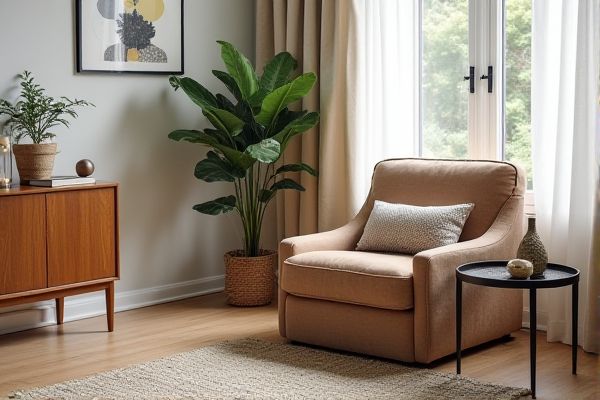
Slipper chairs, characterized by their armless design and low profile, provide a compact and comfortable seating option ideal for smaller spaces, while accent chairs offer a broader variety of styles, shapes, and armrests to serve as statement pieces that enhance any room's decor. Discover how to choose the perfect chair that complements Your space and style by reading the full article.
Table of Comparison
| Feature | Slipper Chair | Accent Chair |
|---|---|---|
| Design | Low seat, armless, minimalist | Varied styles, often includes arms |
| Purpose | Space-saving seating, ideal for small rooms | Decorative focal point, adds personality |
| Comfort | Light cushioning, moderate comfort | Enhanced cushioning, ergonomic options |
| Style | Modern, sleek, simple | Eclectic, bold, statement piece |
| Typical Material | Upholstered fabric, wood frame | Varies: leather, velvet, wood, metal |
| Room Placement | Bedrooms, small spaces | Living rooms, lounges, offices |
| Price Range | Affordable to mid-range | Mid-range to premium |
Understanding Slipper Chairs: Definition and Features
Slipper chairs are armless, low-profile seats designed for comfort and space efficiency, often featuring cushioned seats and backs ideal for bedrooms or small living areas. These chairs prioritize practicality with their compact size and minimalist design, making them distinct from accent chairs, which vary widely in style and often include arms and higher backs for decorative purposes. Understanding the specific features of slipper chairs helps you choose the perfect seating option that balances comfort and aesthetic in your home.
What Is an Accent Chair? Key Characteristics
An accent chair is a versatile seating option designed to enhance a room's aesthetic while providing functional seating. Key characteristics include its distinctive style, often featuring bold colors, unique shapes, or intricate patterns that make it stand out from primary furniture pieces. Unlike slipper chairs, which typically have armless and low-profile designs, accent chairs emphasize visual appeal and can include arms, varying heights, and diverse upholstery to complement the room's decor.
Design Differences: Slipper Chair vs Accent Chair
Slipper chairs feature a low, armless design with a straight back and short legs, making them ideal for small spaces or seating that doesn't overwhelm a room. Accent chairs, on the other hand, come in various styles with arms, high backs, and decorative details to add personality and focal points to your interior decor. Your choice depends on whether you prioritize compact simplicity or bold design elements to enhance your living space.
Comfort and Ergonomics Comparison
Slipper chairs, characterized by their low profile and armless design, offer comfort through a cushioned seat ideal for short-term seating but may lack lumbar support for extended use. Accent chairs often feature higher backs, armrests, and ergonomic contours, providing enhanced support and comfort for prolonged sitting. When prioritizing ergonomics, accent chairs generally outperform slipper chairs by promoting better posture and reducing strain.
Space and Placement Considerations
Slipper chairs are compact, armless seats ideal for small spaces or tight corners, allowing you to maximize floor area without sacrificing comfort. Accent chairs often feature arms and taller backs, requiring more room for placement and movement, making them better suited for larger living areas or spacious bedrooms. When choosing between the two, consider your room's size and layout to ensure your chair complements the existing furniture without overcrowding the space.
Style Versatility: Matching with Room Décor
Slipper chairs offer a sleek and minimalistic design, making them ideal for modern or contemporary room decor with low profiles and clean lines. Accent chairs provide a broader style range, from traditional to eclectic, allowing for bold patterns and detailed upholstery that enhance a room's character. Both chair types can complement various interior themes, but accent chairs often serve as statement pieces, while slipper chairs blend seamlessly with subtle decor schemes.
Material and Upholstery: Options and Trends
Slipper chairs typically feature low-profile wooden or metal frames with sleek, tight upholstery, often in velvet or linen, highlighting minimalist and modern trends. Accent chairs offer more variety in materials, including leather, patterned fabrics, and tufted upholstery that enhance both comfort and style. Your choice between the two depends on the room's design, with slipper chairs favoring subtle elegance and accent chairs providing bold, textured statement pieces.
Price Range and Budget Factors
Slipper chairs generally have a more affordable price range, typically starting around $100 to $300, making them a budget-friendly option for small spaces or temporary seating. Accent chairs, with their diverse styles and materials, can range from $150 up to $1,500 or more, depending on designer brands, upholstery quality, and additional features like tufting or woodwork. Budget factors should include room size, intended use, and desired aesthetic impact, as accent chairs often serve as a focal point while slipper chairs prioritize compact comfort and cost-efficiency.
Pros and Cons: Slipper Chair vs Accent Chair
Slipper chairs offer a low-profile design ideal for small spaces, providing comfort without armrests, but they may lack support for extended seating compared to accent chairs. Accent chairs boast diverse styles and often include armrests, enhancing both aesthetics and comfort, yet they can occupy more space and sometimes overwhelm minimalist rooms. Your choice depends on balancing space constraints with desired functionality and style.
How to Choose the Right Chair for Your Space
Selecting the right chair for your space depends on functionality and aesthetics, where slipper chairs offer low-profile design ideal for tight spaces and minimalist decor. Accent chairs provide versatility with varied styles and heights, perfect for adding color or personality to living rooms and bedrooms. Consider the room size, existing furniture style, and the chair's intended use to balance comfort and visual appeal effectively.
 homyna.com
homyna.com